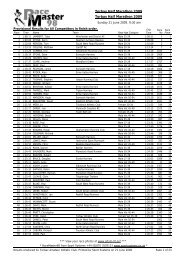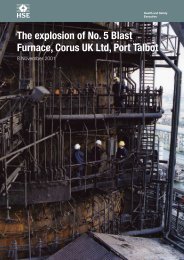A cArbon cApture And storAge network for yorkshire And humber
A cArbon cApture And storAge network for yorkshire And humber
A cArbon cApture And storAge network for yorkshire And humber
Create successful ePaper yourself
Turn your PDF publications into a flip-book with our unique Google optimized e-Paper software.
7.5 INJECTION pRESSURE<br />
A pipeline pressure requirement of up to<br />
170 bar is recommended to be used <strong>for</strong><br />
the purposes of this study given the lack of<br />
detailed knowledge of the individual reservoir<br />
and well differences, and the need to serve<br />
multiple fields over the life of the offshore<br />
trunk pipelines. Though some fields do not<br />
require this high injection pressure the initial<br />
pipeline will be extended to higher pressure<br />
stores. The additional wall thickness does<br />
mean an increase in initial installation cost<br />
<strong>for</strong> the pipeline but the opportunity to<br />
operate at lower design loads must be <strong>for</strong><br />
well over 10 years to prompt installing a<br />
second pipeline due to the high fixed costs<br />
of offshore pipe construction.<br />
7.6 SALINE AQUIFERS<br />
There are no saline <strong>for</strong>mations that have<br />
been characterised sufficiently to have<br />
good estimates of their storage potential<br />
and leakage risk. They are also not closer<br />
than depleted gas fields. However, by coincidence<br />
three with storage capacities of<br />
over 1000mt over lay producing gas fields.<br />
Un<strong>for</strong>tunately there are no robust geological<br />
studies to suggest that these <strong>for</strong>mations are<br />
sealed unlike gas fields which have obviously<br />
trapped rising gases <strong>for</strong> a very long time.<br />
For those aquifers that lie at a shallower<br />
depth than an explored gas field there is<br />
data because of seismic and borehole<br />
results, though it requires analysis to focus<br />
on the aquifer rather than the much deeper<br />
gas field. However much analysis is done,<br />
the final proof is in drilling and injection and<br />
monitoring of a measurable amount of CO2,<br />
as that will provide confidence to rely on that<br />
geological store <strong>for</strong> CO2 <strong>for</strong> large volumes.<br />
Further to the Sleipner experience a number<br />
of other CO2 injection and monitoring<br />
aquifer injection trials are underway, all with<br />
extensive monitoring and modelling. Routing<br />
ideally needs to enable access to, and<br />
assessment of, these three aquifers because<br />
of their large storage potential.<br />
Carbon Capture and Storage Network 25<br />
7.7 GAS FIELD SELECTION<br />
7.7.1 Availability timeline<br />
For pre-2020 availability Leman has the<br />
best date and size features, followed by<br />
Perenco’s Indefatigable & SW, Viking, Victor,<br />
Vulcan, Hewett, Ravenspurn North, Audrey,<br />
Amethyst E & W, and Pickerill. Considerable<br />
caution is required about the availability of<br />
Leman as the operator of half the field is not<br />
likely to decommission be<strong>for</strong>e 2025. There<br />
is potential in a minority of scenario options<br />
<strong>for</strong> an overlap between gas recovery and<br />
CO2 injection which because of connectivity<br />
within the field may be a problem. This can<br />
be resolved be<strong>for</strong>e a pipe route committing<br />
to use Leman is sanctioned.<br />
7.7.2 Distance selection<br />
For a minimum distance <strong>for</strong> first stage<br />
capacity, or desirable if near a pipeline<br />
route to larger stores, the best fields are<br />
Amethyst E & W then Pickerill, followed by<br />
Ravenspurn North and, if via Theddlethorpe,<br />
then Hewett.<br />
7.7.3 Injectivity<br />
Ranking by injectivity, a measure of how<br />
easy it is to inject CO2 into a <strong>for</strong>mation<br />
and size the preferred fields are Viking<br />
and Indefatigable, and Leman and Hewett,<br />
with consideration to Victor, Sean N & S,<br />
Vulcan, Audrey, Barque & Barque S, and<br />
Ravenspurn North. Injectivity is primarily<br />
driven by rock permeability, but other<br />
geological and well design factors<br />
influence the flow rate that will be<br />
achieved in practice.<br />
Fields are often a complex of gas retaining<br />
structures which have varying degrees of<br />
interconnection. The amount of connectivity<br />
impacts the number and design of wells <strong>for</strong><br />
gas recovery, and the same will be true <strong>for</strong><br />
CO2. There<strong>for</strong>e the connectivity of a field’s<br />
storage volume is an important part of the<br />
overall economic flow rate <strong>for</strong> a storage site.<br />
Existing gas field data will help, but saline<br />
fields need more characterisation. More<br />
work on target fields is required to establish<br />
costs and injectivity flow rates be<strong>for</strong>e<br />
finalising a commitment to use a particular<br />
field <strong>for</strong> CO2 storage.<br />
7.7.4 Decommissioning of gas fields<br />
in the study period<br />
This study does not assume reuse of<br />
existing offshore facilities, however there<br />
should be cost reduction opportunities<br />
including the re-use of some wells, better<br />
geological and operational knowledge<br />
transfer into the new activities and deferred<br />
expenditures if CO2 storage neatly followed<br />
gas depletion. There are risks that other<br />
fields besides Shell Indefatigable (currently<br />
decommissioning) will have to commit<br />
to decommissioning be<strong>for</strong>e a CO2 store<br />
commitment can be made.<br />
These include:<br />
• Pickerill by about 2013<br />
• Amethyst E & W, Indefatigable & SW<br />
and Hewett by about 2015<br />
• Audrey by about 2017<br />
• Ravenspurn North by about 2018<br />
• Vulcan by 2020.<br />
Given the lack of a business case <strong>for</strong> storage<br />
it is difficult to see why existing operators will<br />
manage field decommissioning, including well<br />
abandonment details of penetrated aquifers,<br />
in a way that is ideal <strong>for</strong> future CO2 storage.<br />
Providing a viable business case, plus<br />
interpretation of current decommissioning<br />
plans in the light of potential CO2 storage,<br />
is there<strong>for</strong>e important in reducing costs.

















